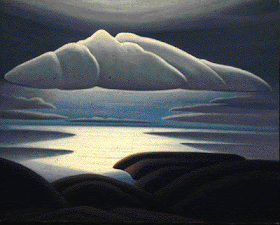
I would like to express how important a role my parents played in encouraging my gifts. My father is a talented cabinetmaker and he would love to sculpt in the evenings around the kitchen table. I would sit and watch him and be amazed at how he could transform a block of wood into something so beautiful. I also remember a neighbour showing me a drawing he did of a farm with a driveway that seemed to leap right off the page. It struck me how two lines could show such depth on a flat surface. In 1966, my family immigrated to Canada from Alkmaar Holland.
I was always drawing and when I was sixteen my parents presented me with an airbrush for my birthday (born Nov. 30/1955). I would experiment with friends' motorcycles and soon I was getting work, doing murals and such. This was in the early seventies when customizing vehicles was at its peek. It would dishearten me however, to see my works get damaged or rust away with time and so I turned my creative energy into a more permanent medium, acrylics on canvas.
In the late 70's I attended a commercial art program at Mohawk College in Brantford. This program was offered through Employment Canada. I felt that a certificate would make me more marketable in obtaining a commercial /graphic arts career. After completing the course, I was hired as a spotlight artist with Sears Canada. The job entailed drawing up ideas for promotional displays. It was a great experience however short lived , due to cutbacks. This then lead to the opportunity to open my own art/graphic studio with my brother, Petrus (www.petrusboots.com) and the never wavering support of my parents.
In 1981 Artistik Images was born. We had a small storefront in Bowmanville, Ontario, offering a number of services such as design, portraiture, signs, framing, custom airbrushing on clothing, anything that would pay the bills. When time allowed, I would paint my own work to build a collection of originals so that I could eventually start to attend local art shows and festivals. My expression in my work was highly detailed and somewhat mystical, as I would hide certain things within the paintings that the viewer would slowly come to realize.
In 1988, with the help of Teresa, I began publishing my originals into Limited Edition lithograph prints, which we would sell to galleries but it proved to be much harder than we had anticipated. Galleries were reluctant in taking on an artist's work without a reputable publisher backing him up. So in 1989, I signed up for a three year period with a distributor /agent who helped get my work into 200 galleries throughout Ontario. My creativity was somewhat stifled and compromised, as he would dictate what to paint, since he "knew" what sold. It became a job. He did however introduce me to Judy Smith, a wonderful gallery owner in Toronto (Westmount Gallery). Her 32+ years experience was refreshing and she certainly knew my heart. She helped me by introducing my work to her client base and hosting a number of shows in her gallery. She had clients commission me to do projects for such corporations as Buckley's, Cardinal Courier and the School Bus Operators of Ontario. Eventually my goal was to become self-publishing and distributing, and this dream became a reality.
I reside near Kinmount Ontario and have two children, Symon 21 and Ariah 17 whom have been the subject of many of my paintings.
I feel very fortunate to be able to have a career that is supported by my creative side and to have the opportunity to meet so many wonderful people.
Please click this line to visit Johannus's website:



















 North Shore, Lake Superior, Lawren Harris
North Shore, Lake Superior, Lawren Harris


 Spanish Red
Spanish Red


